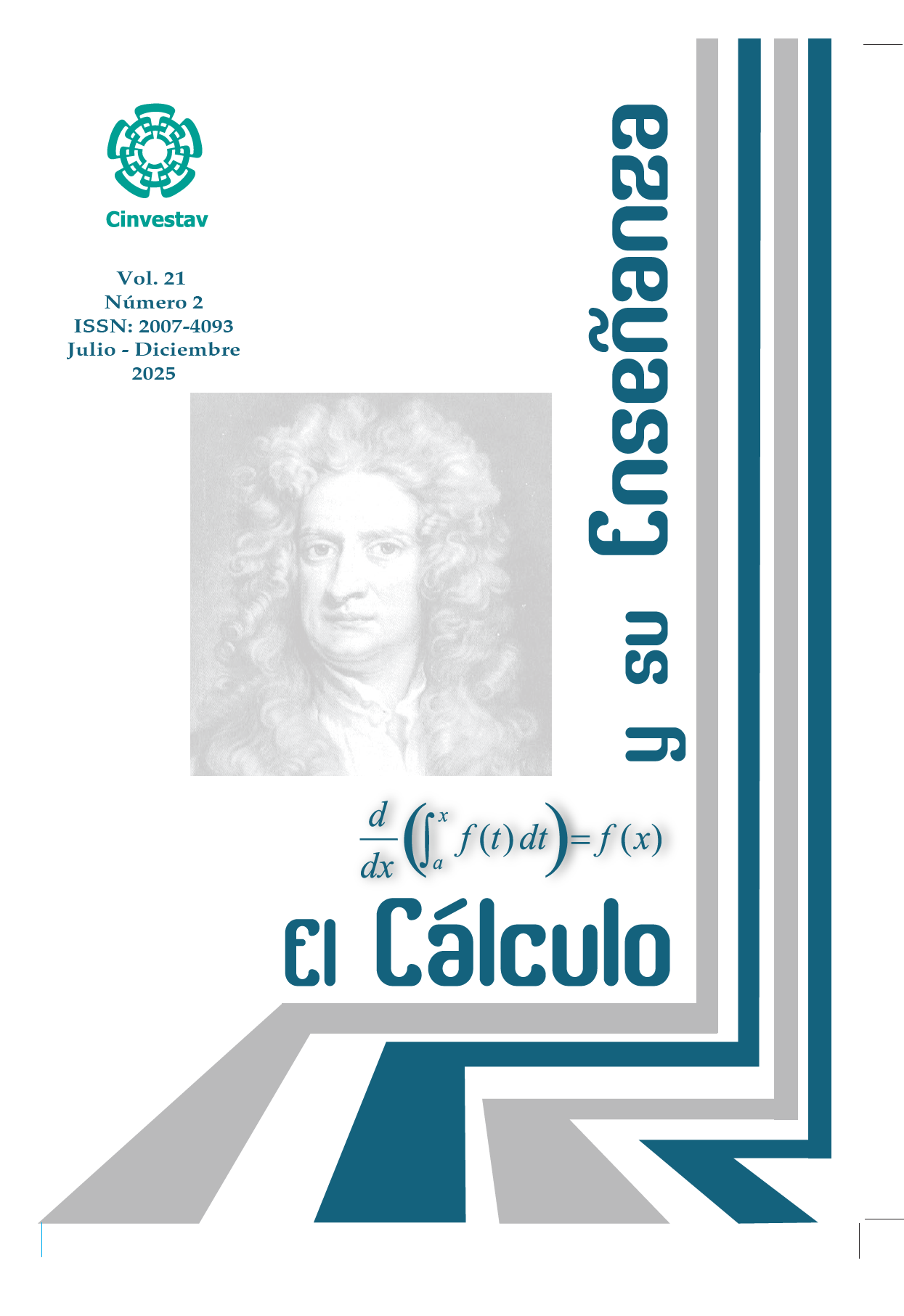La presentación del concepto de variable en libros de texto: Un Análisis Comparativo
Contenido principal del artículo
Resumen
El concepto de variable es fundamental en el aprendizaje del álgebra y otras áreas de las matemáticas, pero su comprensión sigue siendo un desafío significativo para estudiantes de diversos niveles educativos. Este artículo analiza cómo se presenta el concepto de variable en 100 libros de texto de primaria, secundaria, preparatoria y universidad, con el objetivo de identificar patrones, inconsistencias y oportunidades de mejora. Los resultados muestran que la mayoría de los textos lo aborda como un número general o una incógnita, mientras que enfoques más avanzados, como la variable como relación funcional, son menos frecuentes. Se concluye que es necesario integrar definiciones más amplias y contextualizadas para mejorar la comprensión conceptual del estudiante.
Detalles del artículo

Esta obra está bajo una licencia internacional Creative Commons Atribución-NoComercial 4.0.
Citas
Auvil, D., y Poluga, Ch. (1984). Elementary Algebra. Addison Wesley Publishing Company.
Barnett, R. (1960). Algebra: Principles and Applications. McGraw-Hill.
Barnett, R. (1960). Elementary Algebra. Schaum’s.
Barnett, R. (1984). Intermediate Algebra. McGraw-Hill.
Blitzer, R. (2010). College Algebra. Pearson.
Chevallard, Y. (1985). La transposición didáctica. Revue Internationale de Didactique, 2(1), 5-21.
Clement, J. (2000) Analysis of clinical interviews: Foundations and model viability. In Lesh, R. and Kelly, A., Handbook of research methodologies for science and mathematics education (pp. 341-385). Hillsdale, NJ: Lawrence Erlbaum.
Demana, F., Waits, B., Foley, G., Kennedy, D. y Blitzer R. (2009) Matemáticas Universitarias Introductorias con Nivelador Mymathlab. Pearson Educación.
Díaz, J, y Morales, L. (2005). El concepto de variable en los libros de texto. Publicación de la XV Semana Regional de Investigación y Docencia en Matemáticas.
Dogbey, James K., (2010). Concepts of Variable in Middle-Grades Mathematics Textbooks during Four Eras of Mathematics Education in the United States. Graduate Theses and Dissertations. https://scholarcommons.usf.edu/etd/1615
Freeman, D. J., & Porter, A. C. (1989). Do textbooks dictate the content of mathematics instruction in elementary schools? American Educational Research Journal, 26(3), 403-421.
García, B., y Llinares C. (1995). El concepto de función a través de los textos escolares: reflexión sobre una evolución. Qurriculum, No 10-11, pp. 103-115.
Glencoe. (1999). Matemáticas: Aplicaciones y Conexiones. Glencoe/McGraw-Hill.
Gobran A. (1990). Algebra Elemental. Grupo Editorial Iberoamericana.
González A., y Sierra, M. (2004). Metodología de análisis de libros de texto de matemáticas: los puntos críticos en la enseñanza secundaria en España deurante el siglo XX. Enseñanza de las ciencias: revista de investigación y experiencias didácticas, 22(3), 389-408. https://doi.org/10.5565/REV/ENSCIENCIAS.3872
Herrera, E, Cuesta, B, y Escalante, J. (2016). El concepto de variable: un análisis con estudiantes de bachillerato. Educación Matemática, 28(3).
Howson, G. (1995). Mathematics Textbooks: A comparative Study of Grade 8 texts. Vancouver: Pacific Educational Press.
Kieran, C. (1981). Concepts associated with equality symbols. Educational Studies in Mathematics, 12(3), 317-326.
Kieran, C. (1980). Constructing meaning for non trivial equations. Paper presented at the AERA conference, Boston.
Kilhamn, C., Bråting, K., Helenius, O., y Mason, J. (2022). Variables in early algebra: exploring didactic potentials in programming activities. ZDM – Mathematics Education, 54. 1273–1288. https://doi.org/10.1007/s11858-022-01384-0
Kuchemann, D. (1987). Leaming and Teaching Ratio: A Look at some Current Textbooks. En P. Ernest (Ed.) Teaching and Learning Mathematics. Part 2. Perspectives 34. School of Education. University of Exeter.
Lang, S. (1990). Basic Mathematics. Springer-Verlag.
Larson, R., y Hostetler, R. (1985). College Algebra. D.C. Heath and Co.
Lavin, A. (2022). Variability in Variables: An Analysis of Variable Use in A Middle School Mathematics Textbook. Undergraduate Honors Theses. 220. https://scholarsarchive.byu.edu/studentpub_uht/220
Lovaglia, F. M. (1972). Álgebra. Harla.
Love, E. y Pimm, D. (1996). This is so: A text on texts. In International handbook of mathematics edited by Alan Bishop, Ken Clements, Christine Keitel-Kreidt, Jeremy Kilpatrick and Colette Laborde, 371-409. Boston: Kluwer.
Masani, P., Patel, R. y Patil, D. (1968). Cálculo Diferencial e Integral. Publicaciones Cultural S.A.
Matz, M. (1975). Towards a process model for high school algebra errors. Cognitive Psychology, 6(3), 317-339.
Morales, L., Díaz, J. (2008). Un estudio del concepto de variable en los libros de texto. Acta Latinoamericana de Matemática Educativa, 21(1), 201-211.
Murray R. (1969). Álgebra Superior. Schaum´s, McGraw Hill.
NCTM (1979). Gráficas y Relaciones y Funciones. National Council of Teachers of Mathematics.
Okeeffe, L. (2013). A Framework for Textbook Analysis. Int. Rev. Cont. Lear. Res. 2, No. 1, 1-13 (2013)
Otte, M. (1986). What is a Text? En Christiansen, B., Howson, A.G. y Otte, M. (eds.). Perspectives on Mathematics Education, pp. 173-204. Dordrecht: Reidel.
Pang, J., Cho, S. y Kim, J. (2017). An Analysis of Variable Concept in the Elementary Mathematics Textbooks and Workbooks. The Mathematical Education, 56(1), 81–100. https://doi.org/10.7468/MATHEDU.2017.56.1.81
Peterson, J. (1985). Algebra and its Applications. Pearson.
Purcell, E., y Varberg, D. (1998). Cálculo. Prentice Hall.
Reys, R., Lindquist, M, y Lambdin, D. Smith, N. (2014). Helping Children Learn Mathematics. John Wiley & Sons.
Rivers, J., (1990), Contextual Analysis of Problems in Algebra 1 Textbooks, University of South Carolina, Presented at the annual meeting of the American Educational Research Association, April, Boston, Massachusetts
Schmidt, W., Houang, R., y Cogan, L. (2001). A Coherent Curriculum: The Case of Mathematics. Journal of Direct Instruction, 4(1), 13–28.
Steward, J., Redlin, L, y Watson, S. (2013). Precálculo. Matemáticas para el cálculo. Cengage Learning.
Stewart, J. (1994). Calculus. Brooks/Cole Publishing.
Sullivan, M. (2008). Algebra and Trigonometry. Pearson.
Tan, S., (2018). Matemáticas Aplicadas. A los negocios, las ciencias sociales y de la vida. Cengage Learning.
Thompson, R. (1976). Intermediate Algebra. Prindle, Weber & Schmidt, Inc.
Trigueros, M. & Ursini, S. (2000). La conceptualización de la variable en la enseñanza media. Educación Matemática. 12(2).
Valverde, G. and L. Bianchi and R. Wolfe and W. Schmidt and R. Houang, (2002), According to the Book: Using TIMSS to Investigate the Translation of Policy into Practice through the World of Textbooks, London: Kluwer Academic Publishers
Van Dormolen, J. (1986). Textual Analysis. In: Christiansen, B., Howson, A.G., Otte, M. (eds) Perspectives on Mathematics Education. Mathematics Education Library, vol 2. Springer, Dordrecht. https://doi.org/10.1007/978-94-009-4504-3_4
Zill. D. (1987). Cáculo. Grupo Editorial Iberoamérica.
Zill, D., y Dewar, M. (2008). Precálculo, con avances de cálculo. MacGrawHill. Cuarta edición.

